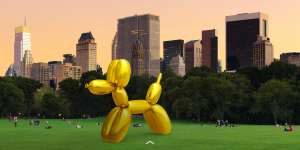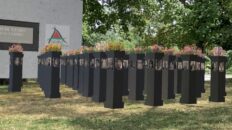For all the attention that augmented reality (AR) is getting, there are equal numbers of cynics and believers in the impact that AR can have. Specifically, if AR has the potential to change the way that people see and interact with the world and art is about bringing ideas to life, what does the future hold for augmented reality art?

Though it remains an emerging field, there are some pretty exciting exhibitions and pieces in the AR art space. For instance, the app EyeJack specializes in the curation and creation of augmented reality art, lets you view works in certain galleries they partner with as animated through your camera lens. Through their app, you are able to see artwork at a gallery as animated, jumping out at you, and even leaving the frame that it was previously contained within. On a bigger scale, Snapchat recently launched an augmented reality collaboration with Jeff Koons where you could see a larger-than-life size version of a balloon dog figurine in Central Park using the snapchat app. What was previously a patch of green in the park becomes replaced by a virtual statue in augmented reality.
At its best, AR art extends the limits of what we previously imagine is possible in art. Through animation or 3D modeling, AR art lets us imagine what a painting would look like if it were animated or re-imagine what a public space would look like if it was filled with sculptures. However, at the end of the day, as much as AR can push the limits of what’s possible, AR is also inherently virtual. Is art that only exists through technology and through a phone’s camera art worth anything? If it isn’t tangible, is it even real?
Augmented reality is valuable tool for art visualization. AR art, like art in the conventional sense of the word, should take what we see in our everyday lives and make a statement, cause us to feel something, and rethink how see the world. AR art is most powerful when brought outside the confines of a gallery space into the real world and shared as a collective experience. For instance, the recent exhibition Dreamworks by Shuli Sade at Montefiore hospital re-imagines the hospital’s garden space by bringing in fantastical, dream-like spheres that reflect the landscape of New York. This kind of AR art fosters collective imagination by creating a world in the hospital that is only accessible through technology.
AR art has the potential to push the limits of our imagination not in spite of being purely virtual, but because it is purely virtual. It brings play and whimsy into everyday life and causes us to see our ordinary surroundings in a new way: through the cutting edge lens of art and technology.
Guest Blog Author: Wendy Ho

Wendy is a content creation intern for Membit this summer. She is excited about finding new ways for people to engage with augmented reality through art and history. Wendy is currently a student at Princeton University.




